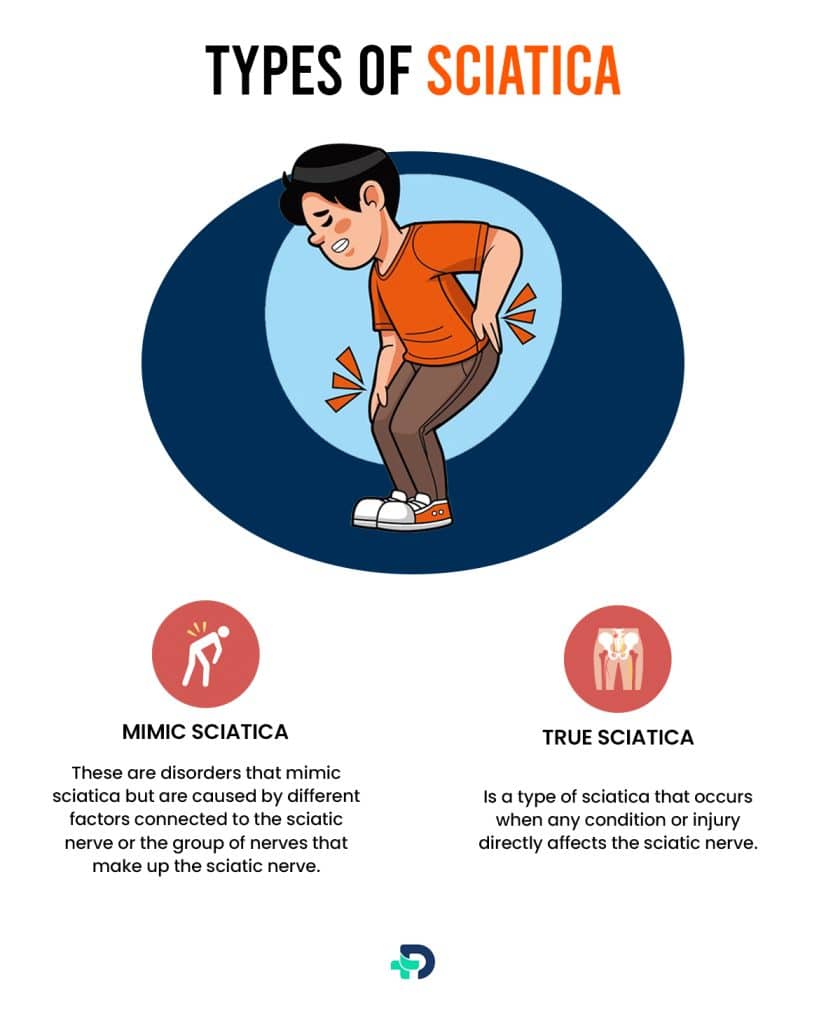Understanding Sciatica: Types, Symptoms, Diagnosis and Treatment

- Sciatica
- 22 Aug 2023
Overview
About Sciatica
Sciatica is a type of nerve pain that arises when the sciatic nerve of a patient becomes inflamed or compressed. It typically goes away 4 to 6 weeks after it first appears in an affected individual. The longest and thickest nerve in the body, the sciatic nerve is actually a bundle of nerves that emerge from five nerve roots that diverge from the spinal cord and can reach a width of up to 2 centimeters.
Every area of your body where the sciatic nerve connects to other nerves will be painful, ranging from mild to severe, if you have sciatica. Your lower back, hips, buttocks, legs, and sometimes even your feet and toes, may be affected by the symptoms of this condition1Overview| Researched based study from Clevelandclinic.org

Causes

What conditions can result in Sciatica?
Conditions that might result in sciatica include:
- Herniated disk (slipped/ruptured disk)
- Degenerative disk disease (spondylosis)
- Spinal stenosis (a disorder that develops when one or more bone holes within the spine start to narrow)
- Foraminal stenosis (a syndrome that develops when pressure on a nerve is put on a bony aperture around a nerve root.)
- Spondylolisthesis (a spinal problem that causes lower back pain)
- Osteoarthritis (degenerative joint disease)
- Injuries
- Pregnancy
- Tumors, cysts, and/or other growths1Causes| Researched based study from Clevelandclinic.org ,3Causes| Researched based study from Nlm.nih.gov
Types

Types of Sciatica
There are two types of Sciatica:
- True Sciatica
- Signs that mimic Sciatica or Sciatica like conditions
True sciatica
- Is a type of sciatica that occurs when any condition or injury directly affects the sciatic nerve.
Sciatica-like conditions
- These are disorders that mimic sciatica but are caused by different factors connected to the sciatic nerve or the group of nerves that make up the sciatic nerve1Types| Researched based study from Clevelandclinic.org
Symptoms
What signs and symptoms indicate Sciatica?
- Pain while sneezing, coughing, and/or walking
- Paresthesia (tingling sensation)
- Numbness
- Muscle weakness
- Urinary/fecal incontinence1Symptoms| Researched based study from Clevelandclinic.org
When should you seek medical care?
If you encounter any of the following symptoms associated with Sciatica, you should seek medical help which includes:
- Any weakened muscles
- A lack of bladder/bowel control.
- Severe discomfort that keeps you from doing your everyday activities and lasts for more than a few hours.
- Following a fall, automobile accident, or another injury-causing incident, sudden, severe pain, numbness, and/or any other sciatica symptoms may appear.1Symptoms| Researched based study from Clevelandclinic.org
Risk Factors
Risk factors of Sciatica
There are numerous potential risk factors for sciatica which include:
- Having an injury, either current or past
- Age-related normal wear and tear
- Excess weight/obesity
- Improper lifting technique and posture
- Diabetes
- Physical inactivity
Current/previous injury:
- Sciatica is more likely to occur if you sustain a lower back or spine injury.
Age-related normal wear and tear
- Pinched nerves, herniated discs, and other issues can cause sciatica that occurs due to regular wear and tear on the spine associated with the aging process.
Excess weight/obesity
- Your spine like a crane must lift the weight you bear in the front of your body. Your back muscles act as a winch and rope, tugging you to stay upright. Your back muscles have to work harder as your weight increases which may lead to back strain, discomfort, and/or other problems as you become obese or gain excess weight.
Improper lifting technique and posture
- If you don’t maintain good body form while doing exercises such as weight lifting, or strength training, you may become susceptible to sciatica, even if you’re physically strong and active.
Diabetes
- Diabetes-related peripheral neuropathy is more likely to develop if you suffer from type 2 diabetes. Your nerves (including the sciatic nerve) may get damaged which can contribute to sciatica.
Physical inactivity
- When a person sits for an extended period of time or doesn’t exercise, sciatica is more likely to develop in that person which can become a risk factor for the condition1Risk factors| Researched based study from Clevelandclinic.org
Diagnosis
How is Sciatica diagnosed?
A healthcare provider diagnoses Sciatica by using a combination of methods that include:
- Reviewing the medical background of a patient and inquiring about symptoms
- Conducting physical examinations such as walking and lifting the leg straight up to check for symptoms associated with the condition in a patient
- Conducting imaging tests such as X-ray, MRI (magnetic resonance imaging), or CT (computed tomography) scans
- Electromyography (a technique for diagnosing the condition of muscles and the nerve cells that control them)1Diagnosis| Researched based study from Clevelandclinic.org ,4Diagnosis| Researched based study from Hopkinsmedicine.org
Treatment
Is there a cure for Sciatica? How is it treated?
Typically, sciatica treatment focuses on reducing discomfort and enhancing mobility. If sciatica persists or worsens, there are numerous therapy options available that are considered based on the severity of the disease which include:
Nonsurgical treatment
When a herniated disc is the underlying cause of sciatica, around 80 to 90% of individuals see gradual improvement without surgery, usually within a few weeks.
The goal of nonsurgical treatment is to assist you in controlling your pain without relying on prescription drugs for an extended period of time which include:
- Injecting cortisone-like medicine in the spinal area
- Performing stretching exercises with short walks.
Surgical treatment
- Surgery is typically recommended when a patient complains of incapacitating leg pain after three or more months of nonsurgical treatment. Your herniated disc or bone spurs will be removed under local, spinal, or general anesthesia to prevent them from pushing on your nerve in this surgical procedure which aid in relieving pain, especially if it is in the legs2Treatment| Researched based study from Aaos.org ,4Treatment| Researched based study from Hopkinsmedicine.org
Complications
Complications of Sciatica
Pain
- Sciatica typically results in complete recovery. But chronic (long-term) pain is a potential side effect or complication that can occur due to sciatica.
Weakness of muscles
- Chronic muscle weakness, such as a “drop foot,” may occur if there is a significant injury to the nerve in question. When this happens, nerve loss results in numbness in your foot, making regular walking challenging or even impossible.
Nerve injury
- Additionally, sciatica may also result in irreversible nerve injury, which could impair feeling in the affected legs1Complications| Researched based study from Clevelandclinic.org ,3Complications| Researched based study from Nlm.nih.gov
Prevention
Can Sciatica be prevented?
Sciatica can be prevented by doing the following the below measures that include:
- Maintaining a straight spine.
- Quitting tobacco products
- Maintaining a healthy weight1Prevention| Researched based study from Clevelandclinic.org
Prognosis
- If long-term problems are rare, the prognosis for sciatica is typically excellent unless you have more severe symptoms.
Takeaway
Takeaway tips
- Sciatica is a type of nerve pain that arises when the sciatic nerve of a patient becomes inflamed or compressed. It typically goes away 4 to 6 weeks after it first appears in an affected individual.
- Pain (while sneezing, coughing, or walking), paresthesia (tingling sensation), numbness, muscle weakness, and/or urinary/fecal incontinence are the symptoms of Sciatica
- Risk factors of Sciatica are injury (either current or past), age-related normal wear & tear, excess weight/obesity, improper lifting technique & posture, diabetes, and/or physical inactivity
- Based on the severity of the condition, Sciatica is treated in two ways, surgical, or non-surgical treatment.
Any feedback on this article?
 This Articles content was accurate
This Articles content was accurate Very Informative Article
Very Informative Article I have a question or a comment
I have a question or a comment
 This article contains inaccurate content
This article contains inaccurate content This article was not helpful
This article was not helpful I have a question or a comment
I have a question or a comment
We appreciate your helpful feedback!
Checkout our social pages
References
-
Cleveland Clinic
Sciatica | Overview | Types | Symptoms | Risk factors | Complications | Prevention
-
American Academy of Orthopaedic Surgeons
Sciatica | Treatment
-
National Library of Medicine
Sciatica | Causes | Complications
-
Johns Hopkins Medicine
Sciatica | Diagnosis | Treatment






































